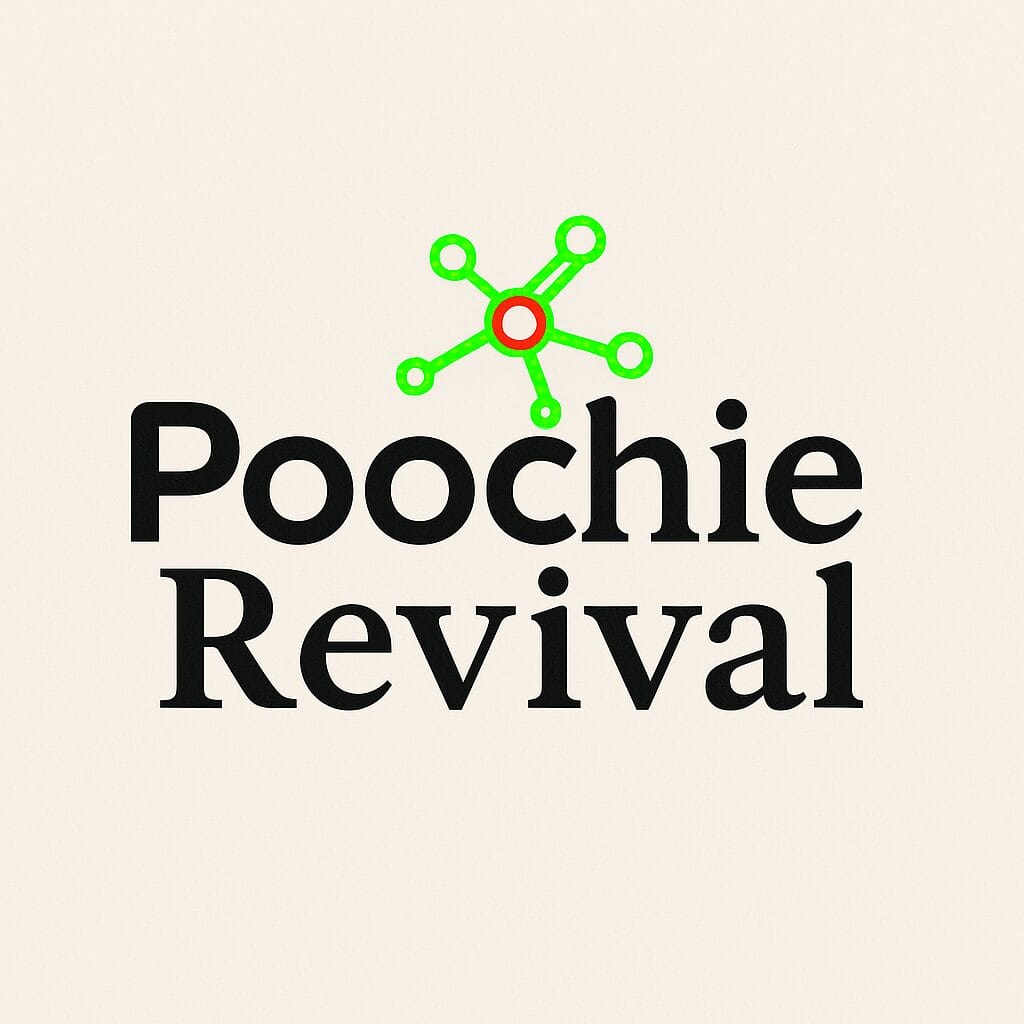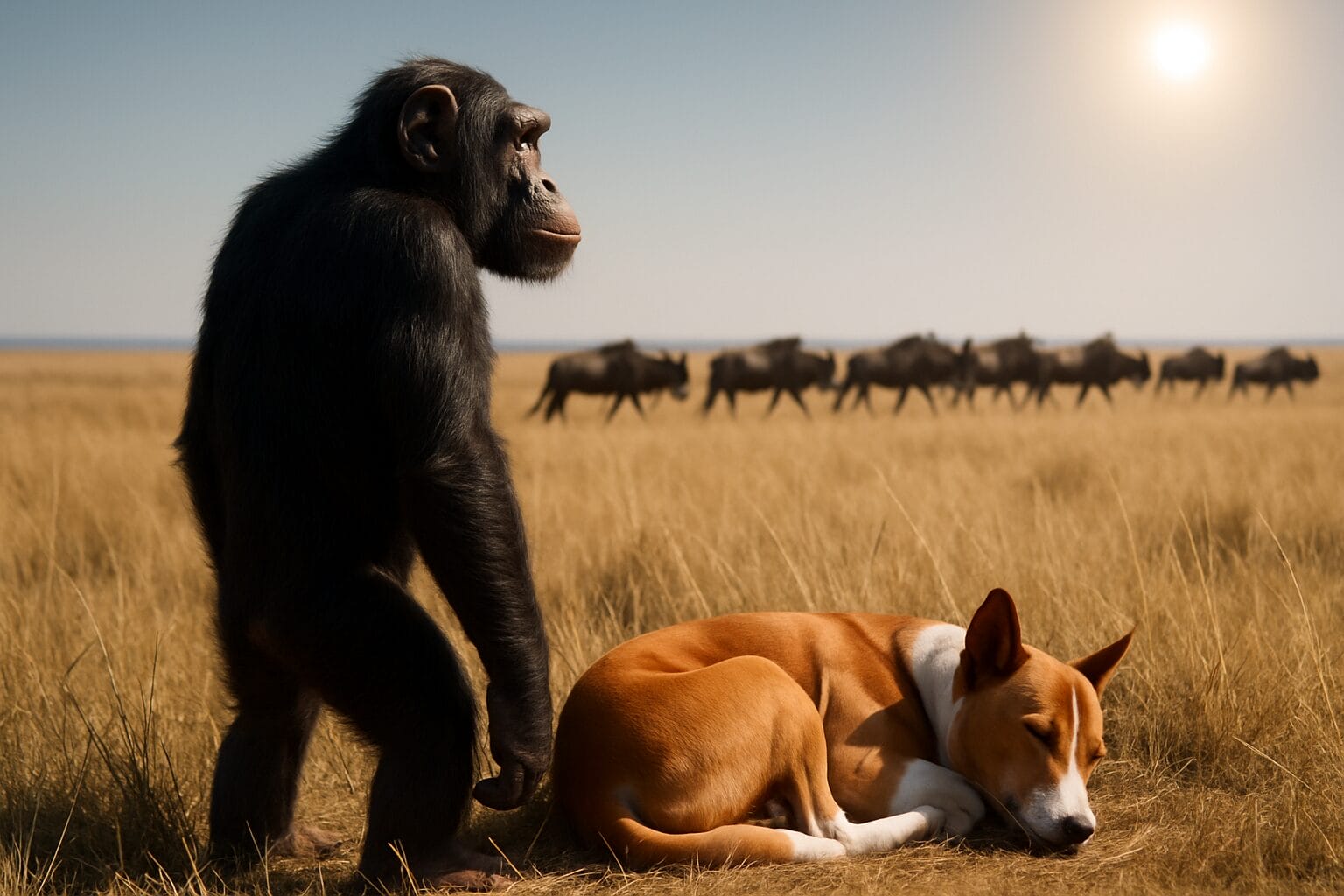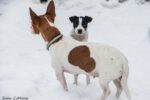Anthropomorphizing a dog means seeing the dog as a somewhat simple, furry, four-legged human. At the same time, the dog’s needs are considered similar to those of a human, whether it concerns meal times or activity levels. This is perhaps the most common form of anthropomorphizing. If the matter is unclear, anthropomorphizing is always wrong. Sometimes it is insignificant, and sometimes the harms are clear, but it is always wrong.
Let’s jump to humans for a moment. This topic requires a story as a foundation.
Long, long ago, we were apes, and not even very large ones. We jumped from tree to tree and ate fruits, berries, young plants, bird chicks… all sorts of things. We were not predators but prey animals below the middle of the food chain. Quite skittish ones at that.
Then someone figured out that maybe we could spend more time on the ground. Due to our tree movement, we already had a suitable pelvis structure to move to the savannah. Far from optimal, but still better than true quadrupeds. Because we were small, we had to stand on two legs to better see over the ground vegetation and savannah grass, and our pelvis allowed for that.
Every now and then, someone claims that we are related to predators because we have eyes at the front of the skull and good stereoscopic vision. And predator’s front and canine teeth. Pathetic ones, but still.
Predators need stereoscopic vision. Without it, a lion would find it very difficult to judge when to pounce on a gnu. Predators’ teeth are needed for tearing large chunks of meat, and the lack of chewing ability doesn’t matter because the food is relatively easy to digest.
A prey animal does not need to judge distances very well. What prey needs is a wide field of vision. It is much more important to spot a lurking lion in a 365-degree full circle field of view than to be able to accurately assess whether the predator is 50 or 10 meters away. The sooner, the better, because escaping relies on running away. That’s why prey animals have eyes on the sides of their skulls.
Neither stereoscopic vision nor predator’s front teeth developed in us due to predator traits, but because we lived in trees. The evolutionary pressure was entirely different, but it led to a similar outcome due to the same need. A monkey quickly becomes an ex-monkey if it cannot judge distances and know whether its jump will reach the next tree or vine.
Our teeth were based on stripping branches and other foraging, and canine teeth were needed for eating small animals. But we are partly hybrids because we have grinding molars and side-moving jaws. Something that is missing from every predator but is present in every prey animal.
When we descended from the trees, we already had
- a pelvis suitable for standing and walking
- vision suitable for judging distances
- teeth suitable for an omnivorous diet
We were moderately bad at everything. We had only one strength, and that was adaptability.
A few more aids from evolution were needed before we became the worst predator species in the planet’s history: the ability to communicate, the ability to cooperate, and opposable thumbs. After that, everything went downhill.
We still weren’t very efficient as budding predators. We weren’t fast, nor at that stage very enduring, and our teeth couldn’t do much damage. Of course, the ability to use sticks and stones as hunting tools and do everything in cooperation helped a bit.
However, I think the importance of cooperation has always been greatly exaggerated. All predators living in packs have a strong ability to cooperate. Still, wolves didn’t manage to kill mammoths to extinction. Humans did. Of course, with the help of climate change, but with the help of a very small human population at the time, mammoths were wiped out without even having a chance to try to adapt.
Our strongest trait was the ability to imagine, because it allowed us to invent new things. And only after that did the ability to speak enable the transfer of knowledge to others and future generations.
But even that wouldn’t have been enough if we hadn’t developed one more exceptional ability. Or not just us, because at that time we were still great apes, so the same ability is present in all species of the great ape branch. Our development just took it to the extreme.
That ability is an exceptionally high resting metabolic energy production, which allows for high consumption.
Humans lived on the savannah and realized that they could take on some kind of predator role and expand their diet. They weren’t strong or fast, so they had to come up with something else.
Cheetahs catch their prey. But the kill had to happen in about 15 seconds, or the cheetah went to bed hungry. There wasn’t enough energy for a second attempt. A pride of lions relied on a secretive encirclement because they didn’t have enough speed to chase a gazelle. Even then, the first attempt usually had to succeed. Wolves relied on wearing down their prey with endurance, but at a certain point, the moose had to be taken down because in a race, the moose would win against the wolf.
We had a different tactic. We were constantly on the move, as long as there was enough light to see where we were stepping. There was no need to take 12-hour naps if the prey got away. Our bodies adapted to being active all day, and sleep was taken care of at night.
All of this required energy, actually quite a lot. That’s why the speed of resting metabolism and energy production had to increase to cover the increased energy demand. Except for the great apes, no other animal had this ability. That’s why they had to rest so much even after a short burst of intense activity.
This brought with it the need for more food. It was managed by being active for so long. There was the ability to cover a larger area and search longer for fruits, berries, fish, and game. This is strongly based on why we should eat so often. Yes, other apes eat a lot too, but for them, it is based on something similar to horses: the available food has so few calories.
A horse moves slowly and grazes all the time. Still, it sleeps several times while grazing, and its actual brisk minutes per day are quite few. If the same horse is put to work for hours, it always sleeps more and longer stretches than a freely grazing idle horse. The reason is chronic sleep deprivation because the horse has to be active for too long periods and produce and consume energy in a way its metabolism cannot handle.
Considering the title, you might already guess where we are headed.
Great apes have higher resting metabolic energy production than any other animal. Humans are in a class of their own. Our resting energy levels are significantly higher than those of any other primate.
Why is that? It’s not known, but there are guesses. Other apes don’t migrate, but humans do. We set a cosmic record in the speed at which we spread across the world. Or almost the whole world, because no one bothered to go to Antarctica.
One reason for this was precisely our ability for long, all-day activity. Probably this ability also improved at the same time because those who couldn’t keep up were left behind.
Energy metabolism was also one reason we shed our fur. The more energy is produced, the more heat is generated. A large part of certain things that need to be done for sled dogs is actually strongly based on cooling — including watering. We handled cooling by shedding fur. At the same time, we had to learn new things, like using clothes, because sometimes it got cold. And so we had an adaptable and adjustable cooling and heating system.
It was easy to invent because we were always active. Or if it sounds better, we were active for a large part of the day.
We still have that ability. That’s why we can wake up at five in the morning and be at work by six. Then work for eight hours, come home, cook food. You can also take the dog for a walk because it hasn’t done anything all day, just lay around. Then it’s time to go to hobbies and squeeze in a bit of Zumba and paddle, or go for a run, finally, you can relax, which means continuous stimulus feeding from TV, social media, or a book.
Finally, you start to feel sleepy and go to bed at 10 PM to get uninterrupted 7 hours of sleep. So you kick the dog awake and move to bed with it to sleep.
No other animal species can be continuously active without sleeping 17 hours straight. And each of us knows that if necessary, or with a strong desire, we can be active for much longer, without sleep.
All because some ape once jumped onto the savannah and decided to go for a walk like a prehistoric Forrest Gump.
But keep in mind that we are the only animal species in the world capable of this. The only one. Others can be quite active, but for a short time. The active time per day for most animals is limited to four hours a day, for some even six hours.
Are you starting to understand why I began this text by highlighting anthropomorphizing? The idea that a dog lives too boring a life because it has to be bored during its daytime naps for 20 hours a day, and therefore it must be activated when the human is not present, is anthropomorphizing at its strongest.
A dog doesn’t sleep most of the day because it’s bored. A dog sleeps because it has no choice. It has to. It comes directly from metabolism. It’s a physiological matter.
Barf once broke quite a few dogs. Therefore, it can be classified as the worst feeding mistake in dog history. Natural feeding of dogs continues on that path paved by barf. But in terms of behavior, activating dogs is reaching the same status. Continuous activation, which is done solely because the owner is active all day, has badly broken dogs’ brains. Too many activated dogs are nervous or become hyperactive. Simply because their sleep has been taken away from them.
Sleep deprivation disrupts, among other things, the human body and hormone function and causes intestinal symptoms (stress stomach is not a new thing) and various mental health problems. A dog is no different from a human in this regard. Or it differs in one way. It’s much easier and faster to cause chronic sleep deprivation in a dog.
It’s a topic of its own, but all this is also why a dog’s constant itching is such a difficult issue.
The most common justification I hear for activation is that the dog wants and does. But if we’re honest, does the dog even have a choice? It is a pack animal bred to be infantile, puppy-like. Of course, it does, because instinct/drives/learned behaviors give no other option. The dog has an internal compulsion.
Greyhounds have never been bred to have a desire to work with humans. Their solution to activation is to eat everything quickly, break the obstacles, and then go to sleep. A Russell, on the other hand, would quickly become a nervous bundle of problems.
Is all activation automatically bad? Of course not. Few things are an absolute evil (like barf and natural feeding are). If a dog is naturally active, it might wake up at 1 PM and realize that mom won’t be home for another four hours — most dogs know the time based on events, but are as clueless about the calendar as a 5-year-old toddler — and decide to entertain itself.
For such dogs, it’s worth offering something, because otherwise, they will break the house. But even then, the idea and purpose are not to provide a full day’s schedule.
Do you want to offer your dog genuine activity? Do something meaningful for the dog in your presence during its active four hours. Also, remember that a dog is an active animal, so let it move. I could say something about the sensibility of leash regulations, but never mind. The dog still needs to be able to be free.
It’s always effective to end with something that makes people nervous.
- Your dog is not a copy of you
- Most activation is based on the owner not having to do anything
- Leash walking, or walking in general, is not stimulating exercise for a dog
- Bicycles, kick bikes, etc. are for the owner, not the dog
Let your dogs sleep!
—
What is the claim about metabolism level based on? Research, as always. You can start here, as it is an easy-to-read article produced by Harvard University: Harvard Scientists Just Discovered Why Humans Burn Energy Like No Other Animal
There are plenty of studies on human energy use, some of which also refer to other animals. This goes slightly off-topic, but it’s also interesting: ScienceDirect Article





